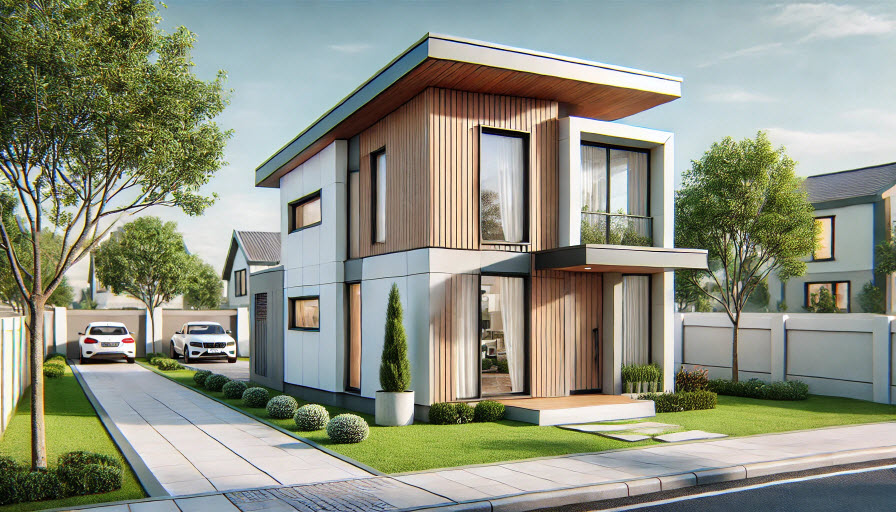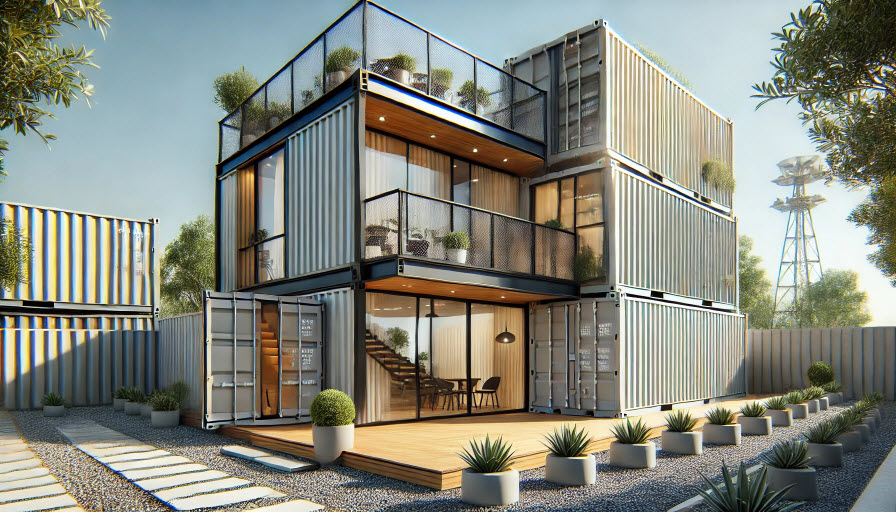Durability and Weather Resistance of Prefabricated Container Homes

Container homes, a modern and eco-friendly housing solution, have gained significant attention for their affordability, versatility, and sustainability. In regions like Uganda and South Sudan, where extreme weather conditions can pose challenges to traditional housing, container homes offer a durable alternative. Built from repurposed shipping containers, these homes are designed to withstand harsh environments, from heavy rains to intense heat, while providing adaptable living spaces.
In this article, we will explore the durability and weather resistance of prefabricated container homes, how they can be customized for different climates, and why they are a promising solution for housing in Africa, particularly Uganda and South Sudan.
What Makes Container Homes Durable?
Container homes are built from steel shipping containers, which are designed to endure the rough conditions of international shipping. These containers are made from Corten steel, a type of steel known for its weather-resistant properties. Corten steel forms a protective layer of rust that shields the container from further corrosion, making it highly durable and long-lasting.
The structural integrity of these containers allows them to resist damage from strong winds, heavy rains, and even minor seismic activity. This durability makes prefabricated container houses an ideal solution for areas prone to extreme weather, as they offer a level of resilience that traditional building materials, like wood or brick, may not provide.

Weather Resistance of Container Homes
Container homes are naturally weather-resistant due to the steel structure they are built from. However, certain modifications and treatments can enhance their ability to withstand extreme weather, ensuring the homes remain comfortable and safe in various climates.
1. Protection Against Heat and Humidity
In Uganda and South Sudan, temperatures can soar, particularly during the dry season. To make prefab container houses suitable for these hot climates, insulation and ventilation are critical. Without proper insulation, steel containers can become excessively hot during the day and lose heat rapidly at night. Adding thermal insulation helps regulate the internal temperature, making the container house more comfortable.
Ventilation systems, such as roof vents, fans, or air conditioning units, can also be installed to ensure airflow, reducing heat buildup inside the home. Additionally, some container houses incorporate green roofs or shading structures to keep the surface of the container cool.
2. Resisting Heavy Rain and Flooding
Both Uganda and South Sudan experience significant rainfall during the wet seasons, which can lead to flooding and water damage. Prefab container homes are naturally elevated due to their design, but additional modifications can be made to further protect them from water. For example, raising the container on stilts or a concrete foundation can prevent flooding from damaging the interior.
To combat water penetration, waterproof coatings are often applied to the exterior of the containers. These coatings seal any gaps or weak points, preventing water from seeping in. Properly installed drainage systems around the home can also divert rainwater away, reducing the risk of flooding.
3. Wind Resistance and Storm Durability
The strong steel frame of a prefab container house makes it resistant to high winds and storms. In coastal areas or regions prone to strong winds, like parts of South Sudan, the container’s structure can easily be anchored to the ground using steel reinforcements or concrete foundations. This ensures the home remains stable even during intense storms or hurricanes.
Furthermore, the compact design of a container house minimizes the surface area exposed to the wind, making it less likely to suffer damage compared to more traditional buildings.
Adapting Prefabricated Container Homes for Different Climates
One of the key advantages of container houses in Africa is their adaptability to different climates. Whether dealing with the hot, dry conditions of South Sudan or the more humid and rainy seasons in Uganda, prefab container homes can be customized to meet the demands of the environment.
1. Hot and Arid Climates
In hot, dry climates like those found in northern Uganda and South Sudan, prefab shipping container houses are often equipped with reflective roof coatings to reduce heat absorption. Insulation is also a must, particularly in the roof and walls, to keep the internal temperature stable.
To further combat the heat, some container houses in these regions use solar panels to power cooling systems or natural ventilation solutions, such as strategically placed windows and vents that allow airflow without the need for electricity.
2. Tropical and Humid Climates
In areas with high humidity and frequent rainfall, like parts of southern Uganda, prefab container homes need additional moisture protection. Insulation materials with moisture resistance properties, such as closed-cell spray foam, are ideal for these climates. This type of insulation not only keeps the house cool but also prevents condensation from forming inside the home, which can lead to mold and mildew.
Elevated foundations are also common in tropical areas to protect the container home from potential flooding. Gutters and drainage systems ensure that rainwater is diverted away from the structure, reducing the risk of water damage.
3. Cold Climates and High Altitudes
Although Uganda and South Sudan are predominantly hot countries, some regions, particularly those at higher altitudes, experience cooler temperatures. In these areas, double-glazed windows and thicker insulation are necessary to keep the container homes warm. Heating systems, powered by solar energy or efficient wood stoves, can be installed to maintain a comfortable indoor environment during the colder months.
Prefab Container Houses: A Sustainable and Affordable Solution for Africa
The growing popularity of container houses in Africa can be attributed to their affordability, sustainability, and adaptability. In regions like Uganda and South Sudan, where the cost of traditional construction can be prohibitively high, prefabricated container houses offer a cost-effective alternative. They are quicker to build, requiring fewer materials and less labor, which makes them an attractive option for both individual homeowners and larger housing projects.
In addition to being cost-efficient, prefab container houses are environmentally friendly. By repurposing old shipping containers, these homes reduce the need for new building materials, cutting down on the environmental impact of construction. They also lend themselves well to off-grid living, as they can be outfitted with solar panels, rainwater harvesting systems, and composting toilets, making them ideal for remote or rural areas in Uganda and South Sudan.
PEB Container Houses: The Future of Housing in Africa
PEB container houses (Pre-Engineered Building container houses) are becoming increasingly popular in Africa due to their enhanced customization options and faster construction times. PEB systems allow for a higher level of precision during the construction process, as the components are manufactured off-site and then assembled on location. This means container houses can be tailored to meet specific design needs, whether for individual homes, schools, or commercial buildings.
In Uganda and South Sudan, PEB container houses are particularly beneficial for disaster relief efforts, temporary housing, and expanding urban development. These homes can be quickly deployed and assembled in areas affected by natural disasters, offering a fast and durable housing solution. Furthermore, they are scalable, meaning that entire communities or neighborhoods can be built using PEB container systems, providing a long-term solution to housing shortages in the region.
Conclusion
Prefabricated poultry farms are a powerful solution to many of the challenges facing poultry farmers in Uganda and South Sudan. By offering better protection against environmental factors, enhanced disease control, and the ability to mitigate the effects of climate variability, these structures are helping farmers build more resilient and productive operations. As the region continues to face challenges from climate change and disease, prefabricated poultry farms will likely play a critical role in ensuring the sustainability and success of the poultry farming industry. By embracing this innovative approach, farmers in Uganda and South Sudan can improve their livelihoods while contributing to the growth of the region’s agricultural sector.FAQ About Prefabricated Container Home
1. What are container houses?
2. How durable are container homes?
3. Are container houses suitable for the climate in Uganda and South Sudan?
4. What is a PEB container house?
5. Are prefab container houses environmentally friendly?
- Ready-to-Assemble Steel Structure to Sudan for the United Nations – Case Study
- Which Steel Cable Tray Type is Best? A Look at Perforated, Ladder, Wire Mesh & Flexible Trays
- The Impact of Temperature Variations on Cold Storage Warehouses in Different Cities of Uganda
- The Impact of Factory Shed Layout on Workflow Efficiency
- Uganda’s Rising Demand for Cold Storage Builders in the Logistics Industry
